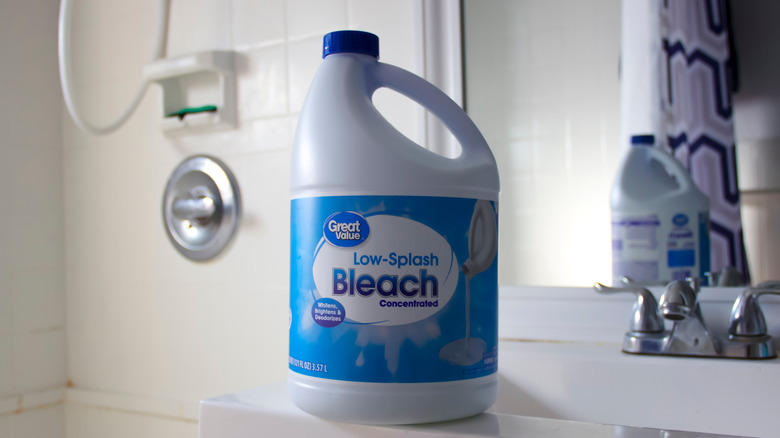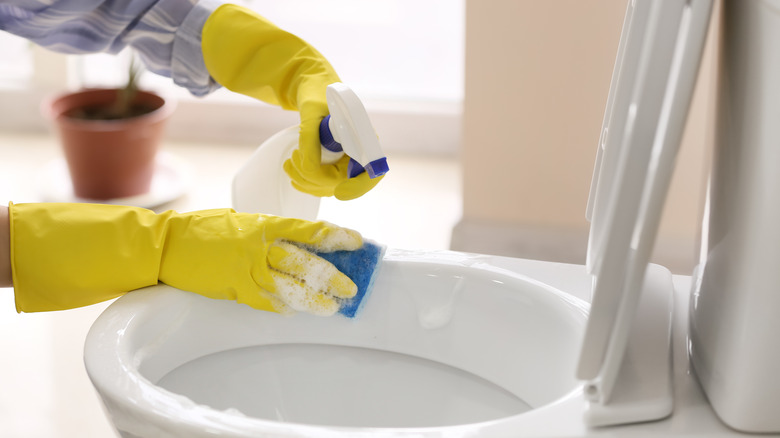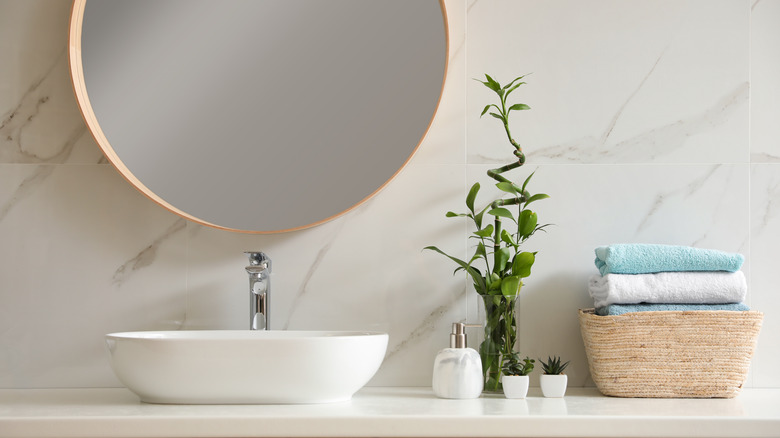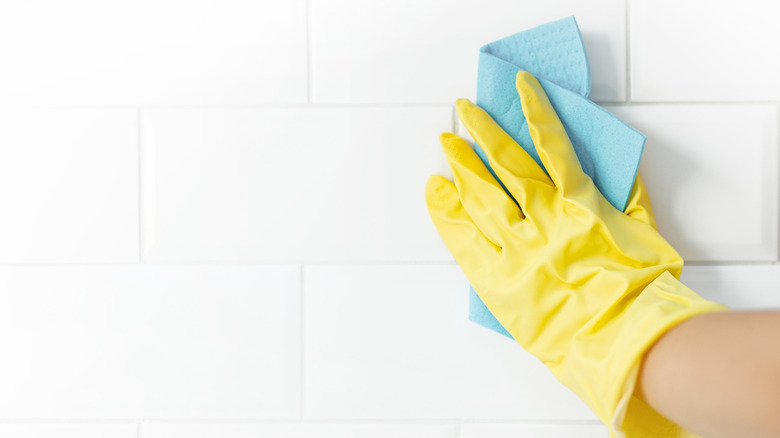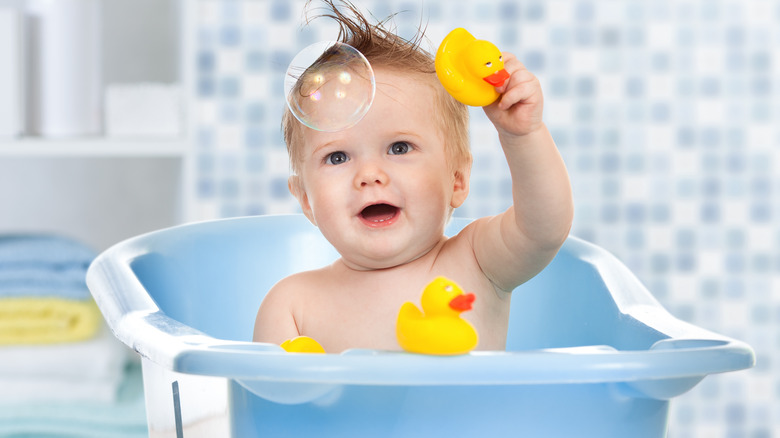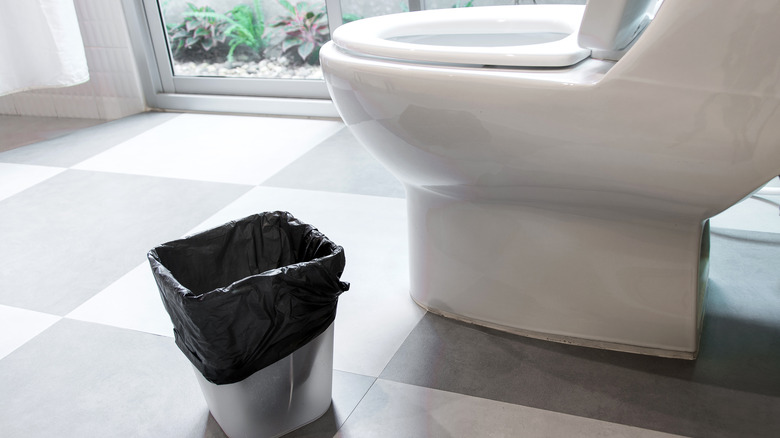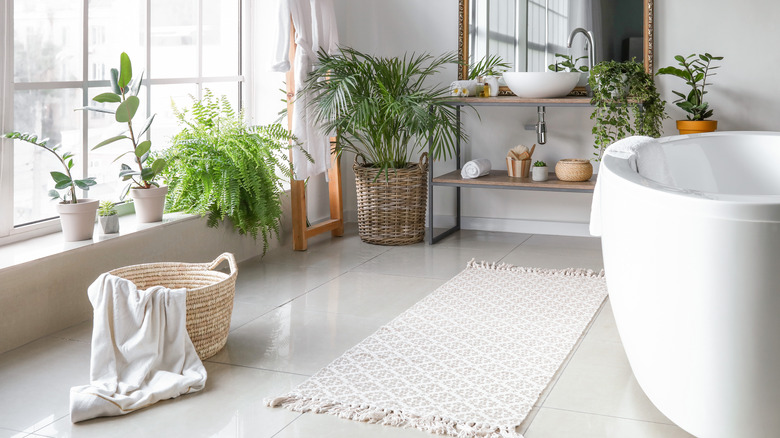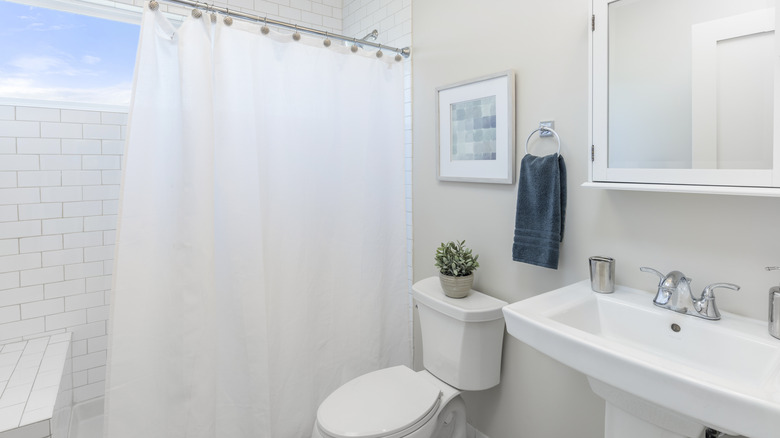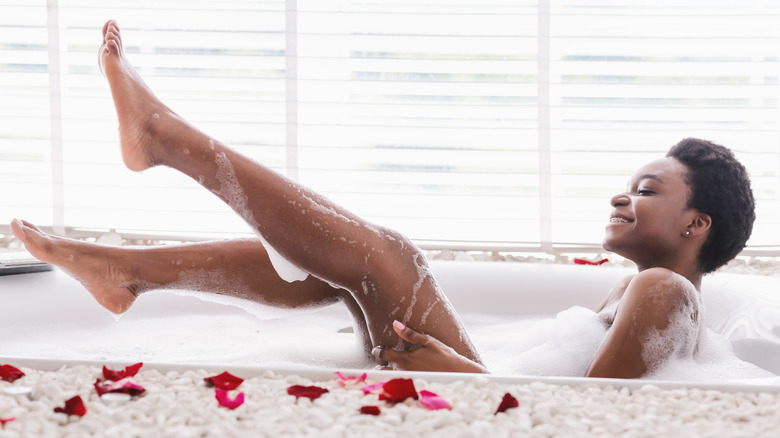8 Genius Ways To Clean Your Bathroom With Bleach
Very few people love cleaning their bathroom(s) but who doesn't love when it's sparkling clean? Regardless of your preference for cleaning bathrooms, it's of the utmost importance that you do so on a regular basis as it can affect the health and safety of anyone who uses them. Microorganisms, bacteria, viruses, and pathogens love to dwell on bathroom surfaces (via Pro Clean Window). They don't just lurk on your toilet, either, but can also be found on your sink, faucets, and towels. Damp bathrooms are a popular location for mold growth, which thrives in moist environments. Another benefit to cleaning your bathroom is eliminating any unpleasant odors. An air freshener might help mask the smell in the short term, but it's best to get at the underlying cause — typically mildew build-up and droplets from the toilet bowl when it's flushed.
For a shiny, germ-free bathroom, expect to spend around 20 to 45 minutes cleaning (per The Maids). Some experts recommend cleaning on a daily basis, but this might not be necessary if you maintain good hygiene habits and tidy up after each use. Either way, the more you clean, the quicker it'll be.
One of the best products to clean your bathroom from head to toe is good old-fashioned household bleach. This tried-and-true product kills the germs living the surfaces of your bathroom while eliminating odors and brightening fixtures. Keep reading to discover eight ways to clean your bathroom using bleach.
1. Clean your toilet with bleach
One of the dirtiest places in your bathroom is hands down the toilet. This bathroom fixture houses the motherload of germs and needs to be sanitized frequently. When it comes to getting rid of those nasty microorganisms and making your toilet smell fresh, bleach is your best friend. If you haven't already, now is a good time to make sure you have your rubber gloves on and a respiratory mask to prevent you from breathing in the toxic fumes. Keep in mind that bleach should be diluted with water before use for safety purposes. In fact, diluting bleach doesn't just make it safer to douse on your toilet bowl, it also makes it work more effectively, according to Apartment Therapy. To make the bleach solution, mix one tablespoon of bleach with one gallon of hot water (via Better Home & Gardens). The best recipient for this solution is a (non-metallic) spray bottle, which makes it easier to spritz all over your toilet, including those hidden, hard-to-reach crevices.
Give the tank and outer surfaces of the toilet a few spritzes and then wipe clean with a paper towel or clean rag. To sanitize the interior of the bowl, spray the solution around the rim and scrub with a toilet brush. It's a good idea to let the solution sit for at least five minutes before flushing. If you follow these steps, you'll have a germ-free, odor-free, and shiny toilet in no time!
2. Use bleach to clean your sink and countertops
To clean your sink and countertops, start by plugging your sink and filling the basin halfway with hot water (via The King Live). Then add a half cup of bleach to the water and let it sit for a few minutes before draining the solution. This will help loosen up any grime and bacteria caked along the sides of the sink.
Once the water has drained, rinse the basin with cold water to get rid of any residue. Note that you should never pour undiluted bleach directly into your pipes, so only drain the sink once you've properly diluted the bleach with water. A scouring sponge or rag will do the trick to get your sink shiny and spot-free. If you'd like, you can finish the treatment by drying the surface with a clean towel or rag. The countertops can be cleaned with the same spray solution you made for the toilet. Just spritz the surfaces and wipe down with a rag.
3. Clean mold and mildew on tile grout with bleach
Have you ever wondered what those black stains on your bathroom walls or in between the tile grout are? Unfortunately, the spots you're seeing are mold, as noted by Today. Luckily, mold is no match for bleach and with just a few steps, your grout will be back to its white, shiny self. You will need the spray container of bleach you used in step one to clean the toilet for this treatment. If you've run out by now, just whip up another batch, grab a coarse brush or toothbrush and you're good to go.
You'll want to start by spraying the mold with the bleach and water mixture and then letting it sit for ten minutes to make sure the solution works its way deep into the porous surface of the grout. Next, you'll take your brush and scrub the areas until the grout looks clean. It's important to rinse the areas with plain water once you're done scrubbing.
4. Sterilize bath toys with bleach
If you have kids, your bathtub is likely lined with rubber bath toys. Unfortunately, these toys are another hot spot for bacteria and mold, which could pose a hazard to your children's health, especially if they're at the age where they put the toys in their mouth. The good news is that bath toys can be easily disinfected with bleach. You'll want to be careful to correctly measure the ratio of water to bleach in your diluted solution as bleach can also be harmful if ingested. One gallon of water to one tablespoon of bleach should do the trick for a good soaking.
Let the toys sit in the mixture for at least five minutes (but preferably longer) before rinsing thoroughly and setting out to air dry (via Better Home & Gardens). Another trick to keeping the bacteria out of the holes in those rubber toys is to plug the openings with a bit of hot glue (per Des Moines Parents). Just squeeze in enough glue to over the hole and let it dry before letting your child play with the toy again.
5. Use bleach to clean your bathroom trash can
When it comes to cleaning your bathroom, you may have overlooked an important place to clean: your trash can. Even with a bag protecting it from the items that get thrown inside, trash cans are another surface replete with bacteria and other microorganisms, especially if it they are located next to the toilet. Before prepping your cleaning supplies, take out the bag and toss it in the kitchen or outside bin. If there are any caked-on bits of debris at the bottom of the can, fill it with warm water and let it sit for several minutes before moving on to the bleach portion of the cleaning.
The trick to cleaning these receptacles is to spray them down with a layer of diluted bleach solution (about one tablespoon of bleach per one gallon of water), according to The King Live. Make sure you spray both the interior and exterior of the trash can before letting the solution sit for approximately 15 minutes. The final step is wiping off the diluted bleach with a clean rag or towel.
6. Wash bathroom rugs with bleach
You might already be washing your bathroom rugs regularly but have you also been adding bleach to your wash? Bathroom towels and rugs, which habitually get damp and take awhile to dry, are another favorite spot for odor-causing bacteria and mold to grow. You should be washing your bath mat at least once a week (per Rinse), and occasionally running it through a cycle with bleach to effectively kill the germs that live between its moist fibers. You can use your regular laundry detergent when washing your rugs, but also add a half cup of bleach to the detergent drawer (via Better Homes & Gardens).
Note that using bleach is only recommended on non-plastic and non-rubber bath rugs as bleach can damage these materials. If you want to sanitize the plastic mat that lines the inside of your bathtub, no need to run it through your washing machine. Simply soak it in a mixture of 1/8 cup bleach and one gallon of water for one hour. Make sure to rinse off all remaining bleach solution when it's done soaking.
7. Clean shower curtains with bleach
Just like with your bathroom rugs, your shower curtain and the plastic liner that acts as a barrier between the inside of the tub and the fabric curtain can be tossed directly into your washing machine. Because these items are also prime locations for mildew and odor build-up, a half cup of bleach along with your regular laundry detergent will do the trick to sanitize them and leave them smelling fresh.
Often times plastic shower curtains can wrinkle in the wash (via Better Homes & Gardens). To combat this, add a few towels to the load and make sure you let it air-dry afterwards. Although you shouldn't have a problem with discoloration on your shower curtain when using a half cup of bleach in your washing machine, you can always spot-test it ahead of time to make sure. Dilute a half cup of bleach in a gallon of water and choose a small, inconspicuous spot on the curtain to test (via Shower Drape). If it doesn't cause any damage, you're good to go.
8. Sanitize your bathtub with bleach
If you enjoy long soaks in your bathtub, you won't be happy to learn that bathtubs are a breeding ground for grime, soap scum, bacteria, and dirt. After all, this is the place where you wash all that sweat, dead skin cells, filth, and bacteria off your skin, and it's bound to leave a residue on the surface of the tub. Don't wait until you see discolored spots, pink soap residue, or worse, mold build-up on your bathtub. Combat the grime regularly with a thorough bleach cleaning. For this cleaning project, you will need a couple of sponges, a dry towel, bleach, and a measuring cup (via The King Live).
First, remove everything from your bathtub, including bottles of hygiene products, washcloths, and bath toys. Then soak a sponge in hot water and wipe down the tub once. At this point, you'll want to get your cleaning solution ready by mixing half a cup of bleach with one gallon of water. Soak the sponge again in the bleach solution and wipe down the tub a second time, including the faucet and shower head, then make sure to let the bleach sit on the surface of the bathtub for at least five minutes. Rinse the tub with cold water before scrubbing the surface in a circular motion with the sponge. Finally, give your bathtub another rinse and dry it with the towel (if preferred). Now you can step back and admire your sparkling bathtub!
